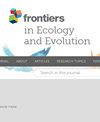假鳕蛾基因组成、性传播和交配兼容性的地域差异,以优化全区防治工作
IF 2.4
3区 环境科学与生态学
Q2 ECOLOGY
引用次数: 0
摘要
性信息素的种内变异是昆虫生殖隔离和物种分化的驱动因素。假鳕蛾(FCM)Thaumatotibia leucotreta(鳞翅目:蛛形纲)是撒哈拉以南非洲(SSA)特有的一种检疫性害虫。目前可用的 FCM 精确控制措施是利用雌性性信息素成分引诱雄性进入诱捕器。然而,关于雌性信息素成分的现有数据,特别是主要信息素成分(E/Z)-8-十二烯基乙酸酯的异构体比率,在撒哈拉以南非洲的种群中并不一致。这种不一致性导致人们猜测,地理上相隔遥远的 FCM 种群之间可能存在生殖隔离,因此可能需要对基于信息素的 FCM 控制工具进行局部调整。然而,这需要对南亚马孙蝇性通讯和种群间交配兼容性的地理差异进行比较评估。因此,我们调查了南非五个地理上相互隔离的 FCM 种群之间的遗传隔离和交配兼容性,并分析了这些种群雌虫体内 (E)- 和 (Z)-8-dodecenyl acetate 的比率。研究发现,所研究的五个种群形成了三个不同的遗传群体,彼此之间的遗传距离较远。交配兼容性测试表明,这些种群之间可以交配,但是雄性在有选择的情况下更喜欢本种群的雌性;在没有选择的情况下,雄性能成功地与所有其他种群的雌性交配并将精子转移给它们。不同种群中(E)-和(Z)-8-十二烯基乙酸酯的比例相似(约为 4:1),表明这种主要的雌性信息素成分不会导致观察到的种群内交配偏好。其他性信息素成分的定性/定量变化是否会影响南非绒螯虾种群内的识别,还有待研究,这将为开发区域特异性引诱剂以实施全区域控制计划提供基础。本文章由计算机程序翻译,如有差异,请以英文原文为准。
Geographic variation in genetic composition, sexual communication and mating compatibility of the False Codling Moth, Thaumatotibia leucotreta for optimisation of area-wide control
Intraspecific variation in sex pheromones is a driver of reproductive isolation and speciation in insects. The False Codling Moth (FCM) Thaumatotibia leucotreta (Lepidoptera: Tortricidae) is a quarantine pest endemic to sub-Saharan Africa (SSA). The currently available precision control measures for FCM use female sex pheromone components to lure males into traps. However, the existing data on the composition of the female sex pheromone, especially the isomer ratios of the main pheromone component (E/Z)-8-dodecenyl acetate, are inconsistent for populations in SSA. This inconsistency led to speculation about possible reproductive isolation between geographically separated FCM populations and the potential need for local adjustment of pheromone-based FCM control tools. This, however, requires a comparative evaluation of geographic variation in FCM sexual communication and inter-population mating compatibility. We therefore investigated genetic isolation and mating compatibility between five geographically isolated FCM populations in South Africa and analysed the ratio of (E)- and (Z)-8-dodecenyl acetate in females from these populations. The five studied populations were found to form three genetically distinct groups with high genetic distances between each other. Mating compatibility tests showed that mating is possible across these groups, however, males preferred females of their own population when given choices; without a choice, males successfully mated with and transferred spermatophores to females from all other populations. The ratio of (E)- and (Z)-8-dodecenyl acetate was similar (c. 4:1) across the populations, indicating that this main female pheromone component does not cause the observed intra-population mating preferences. It remains to be investigated if qualitative/quantitative variation in other sex pheromone components influences intra-population recognition in South African FCM, providing a base for the development of regionally-specific lures for area-wide control programmes.
求助全文
通过发布文献求助,成功后即可免费获取论文全文。
去求助
来源期刊

Frontiers in Ecology and Evolution
Environmental Science-Ecology
CiteScore
4.00
自引率
6.70%
发文量
1143
审稿时长
12 weeks
期刊介绍:
Frontiers in Ecology and Evolution publishes rigorously peer-reviewed research across fundamental and applied sciences, to provide ecological and evolutionary insights into our natural and anthropogenic world, and how it should best be managed. Field Chief Editor Mark A. Elgar at the University of Melbourne is supported by an outstanding Editorial Board of international researchers. This multidisciplinary open-access journal is at the forefront of disseminating and communicating scientific knowledge and impactful discoveries to researchers, academics and the public worldwide.
Eminent biologist and theist Theodosius Dobzhansky’s astute observation that “Nothing in biology makes sense except in the light of evolution” has arguably even broader relevance now than when it was first penned in The American Biology Teacher in 1973. One could similarly argue that not much in evolution makes sense without recourse to ecological concepts: understanding diversity — from microbial adaptations to species assemblages — requires insights from both ecological and evolutionary disciplines. Nowadays, technological developments from other fields allow us to address unprecedented ecological and evolutionary questions of astonishing detail, impressive breadth and compelling inference.
The specialty sections of Frontiers in Ecology and Evolution will publish, under a single platform, contemporary, rigorous research, reviews, opinions, and commentaries that cover the spectrum of ecological and evolutionary inquiry, both fundamental and applied. Articles are peer-reviewed according to the Frontiers review guidelines, which evaluate manuscripts on objective editorial criteria. Through this unique, Frontiers platform for open-access publishing and research networking, Frontiers in Ecology and Evolution aims to provide colleagues and the broader community with ecological and evolutionary insights into our natural and anthropogenic world, and how it might best be managed.
 求助内容:
求助内容: 应助结果提醒方式:
应助结果提醒方式:


